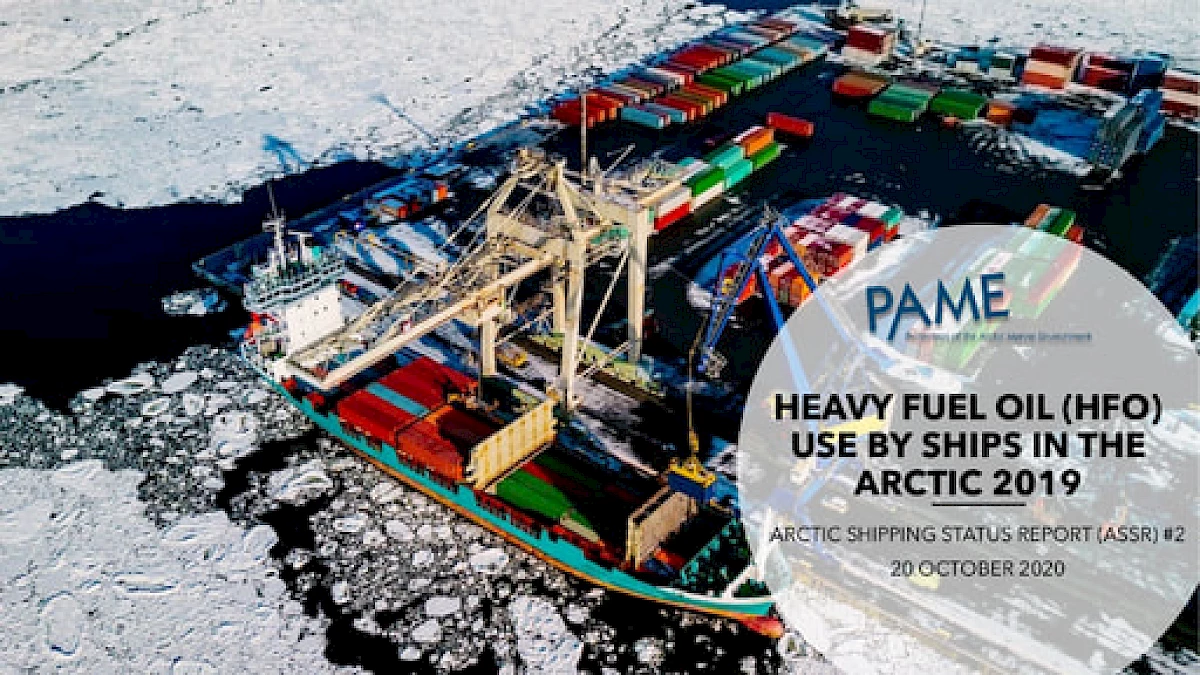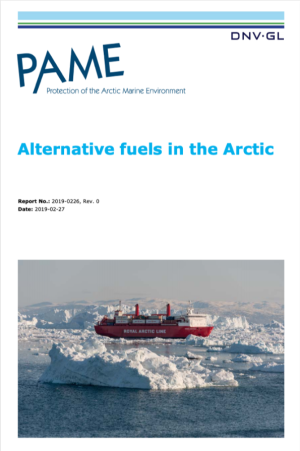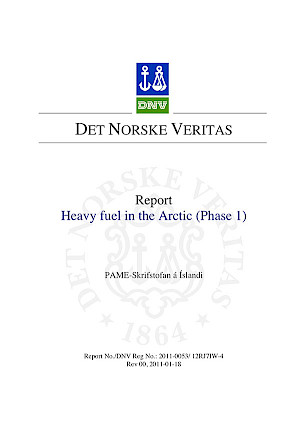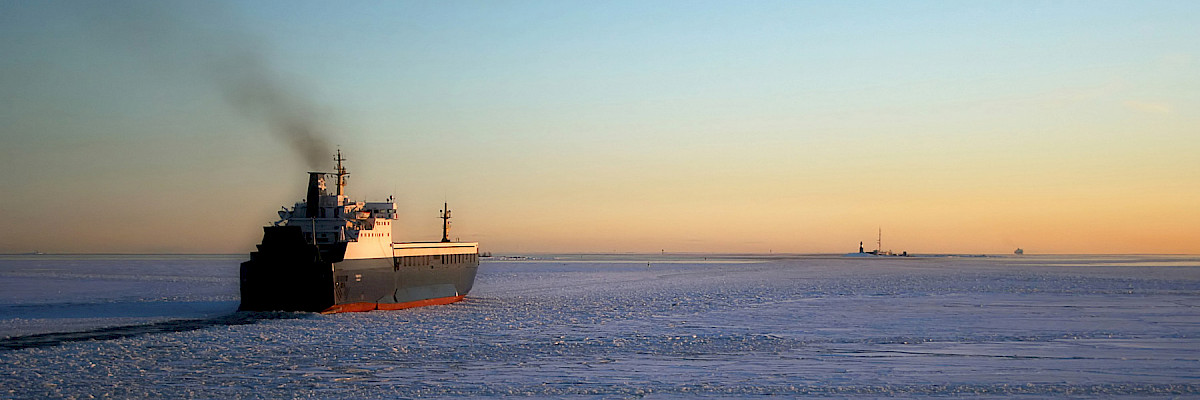
Heavy Fuel Oil in the Arctic
In 2020, PAME issued the Arctic Shipping Status Report – Heavy Fuel Oil (HFO) Use by Ships in the Arctic 2019 (ASSR #2). The report provides information on fuels used by ships in the Arctic in 2019 with a focus on heavy fuel oils (HFO). The Report shows that 10% of ships in Arctic waters as defined by the International Maritime Organization’s Polar Code burned HFO as fuel.
PAME AND HFO
PAME has worked on the topic of heavy fuel oil in the Arctic for over 20 years. PAME's AMSA Report recommended that the Arctic States cooperatively support efforts at the International Maritime Organization (IMO) to augment global ship safety and pollution prevention conventions with specific Arctic requirements. Accordingly, in 2010 PAME initiated the first of several reports tasked with identifying trends and environmental risks, as well as options for minimizing those risks, associated with the use and carriage of heavy fuel oil (HFO) by ships in the Arctic.
PAME’s HFO work includes reports on:
- Risks associated with the use and carriage by ships of HFO in the Arctic
- Analysing fuel use in the Arctic
- Shipping incidents involving releases of HFO and other fuels in the Arctic and effects on the marine environment.
- Hazards for engines and fuel systems using HFO in cold climate
- New report analysing what are the best options to use if HFO is banned
A summary of PAME's work on HFO was submitted to the IMO in 2018. Click here to read the summary (INSERT LINK).
All the reports are available below.
HFO BAN IN THE ARCTIC
The IMO's Sub-Committee on Pollution Prevention and Response (PPR) agreed in February 2020 draft amendments to MARPOL Annex I (addition of a new regulation 43A) to introduce a prohibition on the use and carriage for use as fuel of heavy fuel oil (HFO) by ships in Arctic waters on and after 1 July 2024.
The IMO’s PPR 7 proposed a draft regulation which would phase out the use as fuel oil and carriage for use as fuel oil of HFO by ships in Arctic waters starting in 2024. According to the draft regulation, which has not yet been adopted, States would have the ability to temporarily waive the requirement for individual ships until 1 January 2029, provided they report the particulars to IMO.
As of 2020, a new era of marine fuels is emerging. The reasons for this include stricter new IMO regulations. As of 1 January 2020, the allowable amount of sulphur content in fuel was reduced to 0.5% m/m. This affects the shipping sector worldwide, including in the Arctic These regulations will also affect the type of fuels and fuel blends used by ships in the Arctic. New fuel blends have been and continue to be developed to meet this regulation. As a result, details on fuels used by ships is not as readily available as it was.
INSERT INFO ON HFO BAN
New Low Sulphur Fuels Project
The IMO regulation for a 0.50% global sulphur cap for marine fuels entered into force first of January 2020 - reducing the cap from 3.50% - completely changing the fuel market for ships. Fuel providers responded by offering Low Sulphur Fuels Oil (LSFO – 0.50% sulphur) and ULSFO (Ultra Low Sulphur Fuel Oil – 0.10% sulphur) for ships that previously used different residual fuel oil blends as fuel, including Heavy Fuel Oil (HFO). This created a knowledge gap as what was previosuly a standard, became unknown. The knowledge gap includes both what fuels are onboard ships in the Arctic, and what the charecteristics of these oils are - and importantly how they behave in the cold temperature of Arctic waters which has tremendous effect if and when it comes to spills and cleanup operations.
To fill this knowledge gap, The Low Sulphur Fuels Project, led by Norway, conducted a comprehensive study to seek information from operators to identify which fuels ships in the Arctic are using. The results were published in a report which is to be approved by PAME and EPPR. Experts from Canada, Kingdom of Denmark, Iceland, Finland, Norway, Sweden, USA, China, Germany, Korea, Singapore and World Wide Fund (WWF) have participated in the project. Additionally, experts from industry have also participated as consultants, including from DNV and SINTEF in Norway.
The main objective is to gather information to which fuels ships have been using since 2020, to collect samples of these fuels and to test them to learn more about them.
The project has five parts:
- Questionnaire: To find out what fuel ships are using
- Industry Involvement Workshop: To gather experts to discuss and evaluate
- Fuel oil sampling: Collecting samples to send to different laborotories for testing
- Fate and behavior: Laborotiries identifying how these fuels behave in cold water temperatures
- Toxicity testing: Laborotories testing how toxic the new fuels are
The project has identified the LSFOs and ULSFOs most frequently used by ships operating in Arctic waters, the fuel oil transport volumes (in ton nautical miles), and basic fuel oil characteristics of such fuel oil.
One of the findings is that these global efforts to improve air quality by removing Sulphur from ship fuel has lead to unwanted side effects for oil pollution preparedness and response; clean up is much harder as skimmers, used to clean up the oil from waters when spilled, dont work for these new fuels.
This has consequences as many States have an arsenal of skimmers and oil cleanup equipment for the "old" fuel types which dont work for these new fuels. The report states: "Unlike the majority of high sulphur residual fuels, including high sulphur HFO, the pour point is, with some exceptions, high for VLSFOs and ULFSOs. This implies that the majority of VLSFOs and ULSFOs in use today will solidify if accidently discharged on a cold sea surface. Solidified, sticky and stiff fuel oil will negatively impact the effectiveness of oil spill response equipment from reduced effectiveness to not functioning at all."
This has furthermore consequences in relation to the ban on Heavy Fuel Oil (HFO) in the Arctic as the project found that many of the LSFOs and ULSFOs fall under the definition of HFO as set out in regulation 43.1.2 of MARPOL Annex I and will be prohibited to use and carry for use once the new regulation 43A enters into force, mainly because the density of the fuel oils exceeds 900 kg/m3.
Norway is working closely with the IMO on this topic.
The first report from this project has not been approved by PAME or EPPR.
PAME FIVE REPORT THEME ON HFO
Discussions over a ban on HFO in the Arctic have been recurring.
In 2019, PAME approved the Alternative fuels in the Arctic report. The report describes and assesses a range of alternative fuels and technologies for potential Arctic use. To capture different characteristics and enable a comparison between them, a new method for holistic assessment of fuel and technology options was developed and applied. The options are evaluated and ranked with respect to environmental performance, costs and scalability.
The alternative fuels included are; HFO, Diesel/MGO, Low Sulphur Hybrid, Low Sulphur Hybrid (Arctic optimized), bio diesel (HVO), bio-gas, LNG, full electric, methanol, hydrogen and ammonia. Each of these fuels assessed was allocated a relevant converter, as well as battery hybridization for fuel- and emission optimized engine operation where applicable.
Based on this assessment, the most promising fuel for application in the Arctic is identified, and the potential for reductions in emissions to air is quantified, and oil spill reduction potential evaluated. Furthermore, barriers and drivers for uptake are discussed, included measures and policies to overcome the barriers.
Results were presented for both short and deep sea shipping.
Heavy Fuel Oil in the Arctic Report (Phase I) (2011)
The first of four multi-phase reports commissioned by PAME, the Phase I identifies the risks associated with the use and carriage by ships of HFO in the Arctic and considers potential mitigation strategies to address these identified risks. It additionally examines the reliance on HFO as both fuel and cargo in the Arctic and forecasts HFO use and carriage trends. The report concludes by examining the regulatory environment for HFO at local, regional, and international levels.
Findings:
Based on the analysis, Phase I determined that fishing vessels make up the greatest percentage of vessels operating within the Arctic Region, followed by a mixed grouping of ‘Other Vessels’ comprised primarily of service vessels, research vessels, community support vessels (mainly cargo ships), and passenger vessels. Out of a total of 954 AIS-registered vessels operating in the Arctic during the study period, 189 were identified as most likely running on HFO. The vessels using HFO as fuel typically include larger cargo, tanker, and passenger ships.
With regard to the amount of HFO transported as cargo, obtaining results required making certain assumptions. Based on available bunker samples from the DNVPS database and analysing the traffic patterns of oil tankers, HFO bunkering was identified as being carried out primarily within near or sub-Arctic areas, with only a few instances of samples being registered within the region.
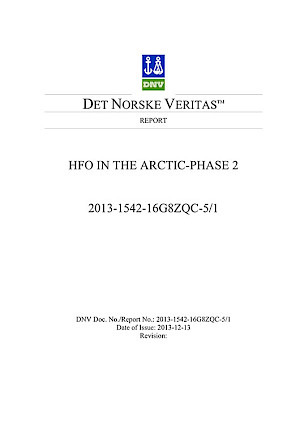 Heavy Fuel in the Arctic Report (Phase II) (2013)
Heavy Fuel in the Arctic Report (Phase II) (2013)
A natural progression of Phase I, the Phase II report (also authored by DNV) provides a more comprehensive picture of maritime traffic, fuel types used, and oil cargo transported within the Arctic Region. Unlike Phase I which drew conclusions from a smaller, four month data set of AIS information (due to satellite operational limitations), Phase II instead draws from an entire years’ worth (2012) of available AIS information.
Based on this data, Phase II identifies vessel composition (type and size), geographical distribution, sailed distances, and operating hours throughout the year. In addition, it models fuel consumption and emissions to air, performs a high-level risk analysis of frequencies of incidents leading to HFO spills, conducts a qualitative review of expected traffic development in the Arctic Region, and concludes with a gap analysis on the regulatory regime for both the use and carriage of HFO in the Arctic.
Findings:
Based on an analysis of AIS data, a total of 1347 unique vessels were found to have operated in the Arctic throughout 2012. From this total, 371 (28%) were identified as most likely using HFO as fuel. As with Phase I, it was generally found that larger ocean going vessels used HFO whereas the smaller and more numerous fishing vessels, as well as community support, research, and service vessels were more likely to rely upon distillate fuels.
This same AIS data was introduced into a risk analysis model to identify accident return periods for a variety of incidents (e.g. grounding, collision, machinery failure) with results indicating that an incident resulting in a spill of oil could on average be expected once every 1.6 years, with the grounding of a tanker representing the greatest spill potential.
Based on these accident return periods, eight risk control options were identified and evaluated, two of which were found to give the highest potential yield on investment: i) area based vessel management (e.g. vessel restrictions during certain times of year, establishment of traffic channels, designation of areas to be avoided, etc.), and ii) speed reductions.
Click here to download the report.
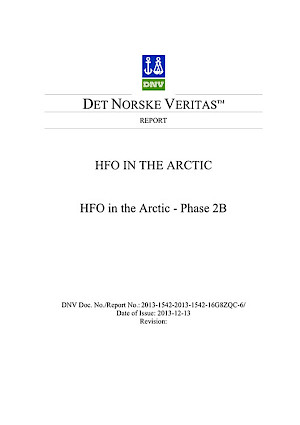 Heavy Fuel in the Arctic (Phase IIb) (2013)
Heavy Fuel in the Arctic (Phase IIb) (2013)
The Phase II(b) report relies upon similar methodologies, calculations and assumptions used during the previous Phase I and Phase II reports, though focuses instead on those areas of the Bering Sea south that fall outside of IMO’s definition of Arctic used for the Polar Code, though within the geographic scope of the 2009 Arctic Marine Shipping Assessment (AMSA). Further, whereas Phase II relies upon AIS data from 2012, the II(b) is based on a dataset covering August 2012 to August 2013.
Findings:
Vessels demographics in the Bering Sea region are significantly different when compared against the demographics identified in the larger area of study analysed in the previous Phase II report, with traffic comprised predominately by the intercontinental shipping of large bulk carriers and container vessels operating along the Great Circle Route, the majority of which use HFO as fuel.
Unlike the previous report where Arctic ship traffic is generally identified by huge variations in operational hours and sailed distances throughout the year , the majority of the Great Circle Route traffic is not affected by sea ice and other seasonal variations.
The Phase II(b) report identified groundings of tankers as being at greatest risk of resulting in an accidental oil spill, though this risk is restricted to certain areas along the Aleutian Chain and not to those parts of the Great Circle Route located further from shore. An incident of this type was found by the Phase II(b) report as likely to happen once every two years within the Bering Sea.
Click here to download the report.
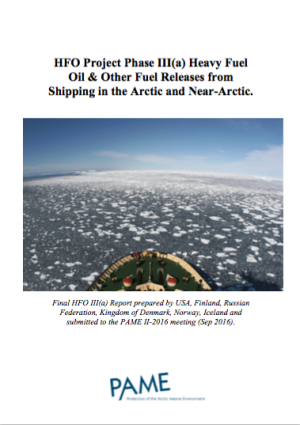 Heavy Fuel in the Arctic Report (Phase IIIa) (2016)
Heavy Fuel in the Arctic Report (Phase IIIa) (2016)
The Phase III(a) report examines shipping incidents involving releases of HFO and other fuels in the Arctic and near-Arctic marine environment. The first section of the report provides a general overview and description of the characteristics of HFO. The second section identifies shipping incidents in the region involving HFO and other oil releases and any resulting reported liability. This information is captured in a separate annex of shipping incidents and sources. The third and final section of the Phase III(a) report examines the effect of HFO releases on the marine environment.
Findings:
The appendix accompanying this report captures shipping incidents between 1970 and 2014 identified in publicly available sources that involved a release or spill from a vessel of oil and any resulting liability from such release. 13 incidents of HFO release were identified while other non-HFO incidents were also captured. The majority of these incidents occurred in near-Arctic waters, which for purposes of this report encompass those waters north of latitude 55° N.
Although the effect of HFO releases on the Arctic marine environment requires more study, the Phase III(a) identifies three key factors that influence the consequence of an oil or analogous HFO discharge into the marine environment: i) the properties of the HFO; ii) the characteristics of the Arctic ecosystem and its inhabitants, and; iii) the nature of the clean-up or remediation process. While the first two aspects are addressed, the third remains outside the scope of this report.
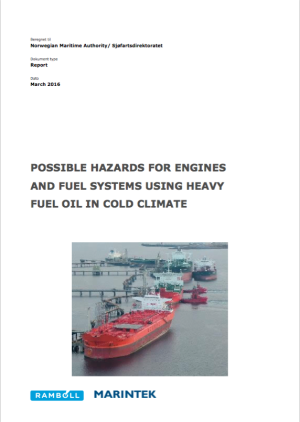 Heavy Fuel in the Arctic Report - Phase III(b) (2016)
Heavy Fuel in the Arctic Report - Phase III(b) (2016)
The Phase III(b) report investigates the possible hazards to engines and fuel systems using HFO in cold climates by comparing the rate of engine or fuel system failures for ships that use HFO in the Arctic to the rate of similar failures for ships that rely upon other fuel types in similar Arctic conditions. HFO characteristics and operational challenges related to HFO use by ships are explained, and known risk factors related to HFO operation are discussed.
Findings:
The Phase III(b) report identifies three primary factors for engine failure or engine stop for ships that use HFO as fuel: i) risks related to disruption of fuel supply; ii) risks related to fuel quality, and; iii) risks related to fuel switchover. Moreover, the report highlights that the safe use of HFO as fuel requires careful attention by skilled personnel following established on-board procedures. Because ‘off-spec’ fuel is probably the most important risk factor for engine failure or loss of propulsion, effective on-board fuel management will therefore significantly reduce the risk of engine break-down, engine repair, or grounding.
Click here to download the report.
 Arctic Council Working Group
Arctic Council Working Group 